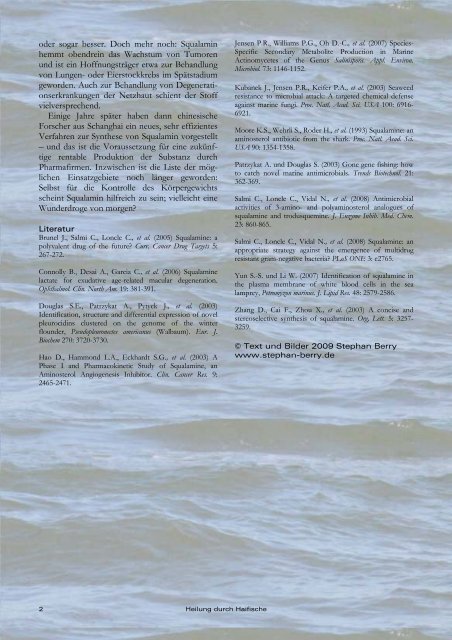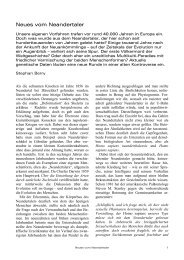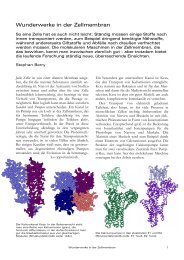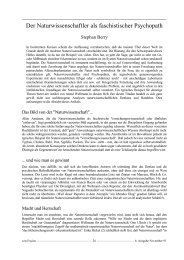Heilung durch Haifische - Stephan Berry
Heilung durch Haifische - Stephan Berry
Heilung durch Haifische - Stephan Berry
Sie wollen auch ein ePaper? Erhöhen Sie die Reichweite Ihrer Titel.
YUMPU macht aus Druck-PDFs automatisch weboptimierte ePaper, die Google liebt.
oder sogar besser. Doch mehr noch: Squalamin<br />
hemmt obendrein das Wachstum von Tumoren<br />
und ist ein Hoffnungsträger etwa zur Behandlung<br />
von Lungen- oder Eierstockkrebs im Spätstadium<br />
geworden. Auch zur Behandlung von Degenerationserkrankungen<br />
der Netzhaut schient der Stoff<br />
vielversprechend.<br />
Einige Jahre später haben dann chinesische<br />
Forscher aus Schanghai ein neues, sehr effizientes<br />
Verfahren zur Synthese von Squalamin vorgestellt<br />
– und das ist die Voraussetzung für eine zukünftige<br />
rentable Produktion der Substanz <strong>durch</strong><br />
Pharmafirmen. Inzwischen ist die Liste der möglichen<br />
Einsatzgebiete noch länger geworden:<br />
Selbst für die Kontrolle des Körpergewichts<br />
scheint Squalamin hilfreich zu sein; vielleicht eine<br />
Wunderdroge von morgen?<br />
Literatur<br />
Brunel J., Salmi C., Loncle C., et al. (2005) Squalamine: a<br />
polyvalent drug of the future? Curr. Cancer Drug Targets 5:<br />
267-272.<br />
Connolly B., Desai A., Garcia C., et al. (2006) Squalamine<br />
lactate for exudative age-related macular degeneration.<br />
Ophthalmol. Clin. North Am. 19: 381-391.<br />
Douglas S.E., Patrzykat A., Pytyck J., et al. (2003)<br />
Identification, structure and differential expression of novel<br />
pleurocidins clustered on the genome of the winter<br />
flounder, Pseudopleuronectes americanus (Walbaum). Eur. J.<br />
Biochem 270: 3720-3730.<br />
Hao D., Hammond L.A., Eckhardt S.G., et al. (2003) A<br />
Phase I and Pharmacokinetic Study of Squalamine, an<br />
Aminosterol Angiogenesis Inhibitor. Clin. Cancer Res. 9:<br />
2465-2471.<br />
Jensen P.R., Williams P.G., Oh D.-C., et al. (2007) Species-<br />
Specific Secondary Metabolite Production in Marine<br />
Actinomycetes of the Genus Salinispora. Appl. Environ.<br />
Microbiol. 73: 1146-1152.<br />
Kubanek J., Jensen P.R., Keifer P.A., et al. (2003) Seaweed<br />
resistance to microbial attack: A targeted chemical defense<br />
against marine fungi. Proc. Natl. Acad. Sci. USA 100: 6916-<br />
6921.<br />
Moore K.S., Wehrli S., Roder H., et al. (1993) Squalamine: an<br />
aminosterol antibiotic from the shark. Proc. Natl. Acad. Sci.<br />
USA 90: 1354-1358.<br />
Patrzykat A. und Douglas S. (2003) Gone gene fishing: how<br />
to catch novel marine antimicrobials. Trends Biotechnol. 21:<br />
362-369.<br />
Salmi C., Loncle C., Vidal N., et al. (2008) Antimicrobial<br />
activities of 3-amino- and polyaminosterol analogues of<br />
squalamine and trodusquemine. J. Enzyme Inhib. Med. Chem.<br />
23: 860-865.<br />
Salmi C., Loncle C., Vidal N., et al. (2008) Squalamine: an<br />
appropriate strategy against the emergence of multidrug<br />
resistant gram-negative bacteria? PLoS ONE 3: e2765.<br />
Yun S.-S. und Li W. (2007) Identification of squalamine in<br />
the plasma membrane of white blood cells in the sea<br />
lamprey, Petromyzon marinus. J. Lipid Res. 48: 2579-2586.<br />
Zhang D., Cai F., Zhou X., et al. (2003) A concise and<br />
stereoselective synthesis of squalamine. Org, Lett. 5: 3257-<br />
3259.<br />
© Text und Bilder 2009 <strong>Stephan</strong> <strong>Berry</strong><br />
www.stephan-berry.de<br />
2<br />
<strong>Heilung</strong> <strong>durch</strong> <strong>Haifische</strong>










